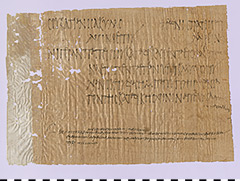P. 11532 (SB I 4639)
In some ways it may be surprising that this document of the Greco-Roman period is one of the most discussed papyri in Berlin. The content of this piece, bought by Friedrich Zucker in Giza 1909, seems to be more or less casual: Prefect Subatianus Aquila messages Theon, strategist of the County Arsinoe, in eleven lines he released Niger, son of Papirius, from convict labour. Apparently, Niger had been sentenced to five years in the alabaster mines by Subatianus’ predecessor Claudius Julianus, vir perfectissimus. In court the praefectus Aegypti played a role similar to other governors, almost contrary to the status of Egypt as the province of special arrangements. The degree of penalty is by five years according to our knowledge rather conventional in the province of Egypt, although the punishment itself is quite harsh.
However, the formal appearance of the papyrus strikes the eye: the official document attracts attention by its neat, almost calligraphic chancery-style in l. 1–6b. Its well-sized letters excel by being highly distinguishable. Beyond the practical function of conveying information they fulfil a decorative function of representation. But this is by far not the only visible peculiarity: There are different styles of writing on the papyrus. In l.6b another type adds a greeting/health phrase in a rather informal style. Nearly unremarkable next to the dominant chancery-style it is nonetheless one of the highlights of this piece. The words are probably originating from the prefect himself and thus work as a kind of signature. Differences in the handwriting occur again along with the typical confirmation by a Mauricianus Menius. The same style closes the formal composition by adding the date, the first day, the new moon of the Egyptian month Tybi. Probably these lines were written by the chairman if the chancellery. A last change of the handwriting appears in between. Here the year is annotated according to the reign of two emperors who are nowadays better known as Septimius Severus and Caracalla. It might have been a minor scribe who wrote this down.
It is, however, controversial, whether every alteration of style represents an alteration of author. All lines were written by an experienced writer anyway. Especially the chancery style doesn’t attempt to save place. At the same time, a lot of the papyrus is blank. Thus, not only the readability but also the quality is extended. In the whole text no abbreviation is to be found. The only exception is the notation of the year, which allows in addition with the last line the age determination to December 27, 209 A.D. The verso is blank – which is by no means regular case. According to this the papyrus wasn’t reused. On its left side a piece of parchment was attached to protect the message. And indeed, the state of preservation is remarkable. But still, the rarity of the object compared to the big number of copies of legal texts can only be acknowledged when seen as an original document. It delivers us the unique quasi-autograph of a prefect and brings us much closer than usual to the practice and writing of a chancellery in Greco-Roman times.



